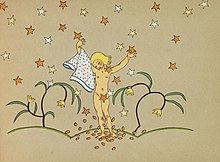Tom Seidmann-Freud
Tom Seidmann-Freud(November 17, 1892 – February 7, 1930) was an Austrian painter, children's book author and illustrator.
Tom Seidmann-Freud | |
|---|---|
 | |
| Born | Martha Gertrud Freud November 17, 1892 |
| Died | February 7, 1930 |
| Nationality | Austria |
| Other names | Freud, Tom Seidmann-; Seidmann-Freud; Zaidman Froid, Tom; Seidmann-Freud, Martha Gertrud |
Biography

Tom Seidmann-Freud was born in Vienna as Martha Gertrud Freud on 17 November 1892 to Maria 'Mitzi' Freud, sister to psychoanalyst Sigmund Freud and Maurice (Moritz). In 1898 the family moved to Berlin, where her father ran an import business. Seidmann-Freud had an older sister, Lily Freud later Lily Marlé. She also had a younger brother Theodor who in 1922 drowned in Mäckersee, north of Berlin. From the time Seidmann-Freud was 15 she used the name Tom. Seidmann-Freud moved to London to art school in 1911 when she finished school. She focused on Art Nouveau picture books. Her first successes were in 1914. When she returned to Berlin Seidmann-Freud studied in the School of applied Arts working with wood, stone and copper and experimenting with graphic design, drawing and decorative painting. She remained in Berlin throughout the First World War.[1][2][3][4][5][6]
Between 1918 and 1920 Seidmann-Freud lived in Munich where she met writer Jakob 'Yankel' Seidmann. They married and had one daughter Angela in 1922. The pair co-founded Peregrin publishing house which focused on religious issues for Jewish immigrants. Seidmann-Freud picture book "Die Fischreise" was published by them in 1923. Seidmann-Freud also created play and transformation books for children aimed at encouraging children to read and write. The books were all published in Sütterlin script which has limited the distribution since 1949. The couple worked closely with Hayim Nahman Bialik and founded a new publishing house called Ophir in July 1922. Their collaboration failed when Bialik delivered only part of his contract and left Germany for Tel Aviv in 1924. When the Great depression hit Germany in 1929, the company went bankrupt. Seidmann-Freud's husband committed suicide. Seidmann-Freud sank into a severe depression and took an overdose of sleeping pills on February 7, 1930. She is buried with her husband in the Berlin-Weissensee Jewish cemetery. [1][2][3][4][6]
After her death
As Germany moved towards war and the situation became more dangerous for Jews, Seidmann-Freud's daughter, adopted by Lily and her husband Arnold Marlé was sent as part of a child transport to Palestine in 1938. There she took the Hebrew name Aviva where she had children herself and died in May 2011. Mitzi Freud was transported to Treblinka in 1942, where she murdered in the Holocaust. Many of Seidmann-Freud's books were burned during that time.[1][2][4][6]
References
- "Tom Seidmann-Freud". documenta 14. 2017-09-29. Retrieved 2020-07-06.
- "The Life and Work of Tom Seidmann-Freud". Freud Museum London. 2018-11-01. Retrieved 2020-07-06.
- "The Tragedy of Tom Seidmann-Freud: An Innovative Jewish Illustrator". The Librarians. 2017-11-20. Retrieved 2020-07-06.
- "Tom Seidmann-Freud". Oxford Reference. doi:10.1093/oi/authority.20110803100452539.
- Congress, The Library of. "LC Linked Data Service: Authorities and Vocabularies (Library of Congress)". id.loc.gov.
- "The Tragic Life and Surreal Illustrations of Tom Seidmann-Freud, Sigmund Freud's Niece". Tablet Magazine. 28 February 2012.